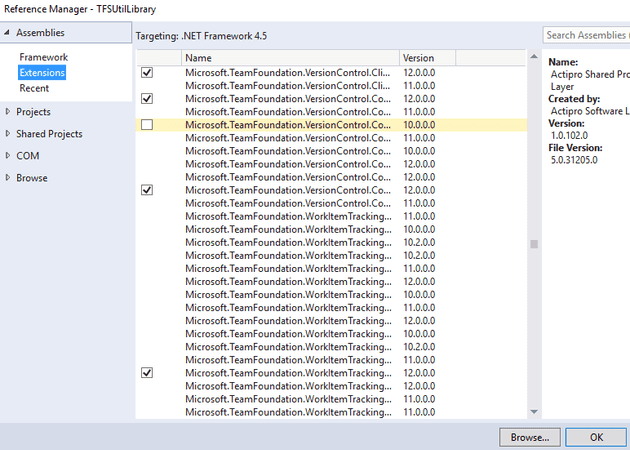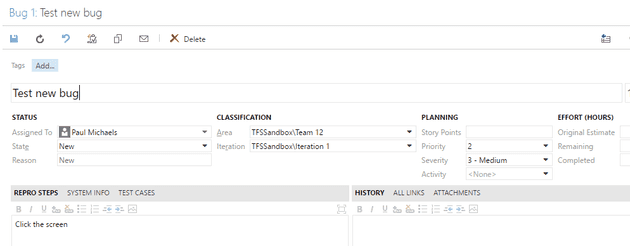If you’re creating a TFS API program from scratch, the first thing that you’ll need is to reference the TFS API libraries. They are in extensions:
Don’t worry too much about which one’s you’ll need just yet, when you start to write some code, this will be more obvious. The next stage is to create a function that creates your bug; it might look like this:
private static ActionResult CreateNewBug(Project teamProject, string title, string description,
string area, string iteration, string assignee, string reproductionSteps)
{
WorkItemType workItemType = teamProject.WorkItemTypes["Bug"];
// Create the work item.
WorkItem newBug = new WorkItem(workItemType);
newBug.Title = title;
newBug.Description = description;
newBug.AreaPath = area;
newBug.IterationPath = iteration;
newBug.Fields["Assigned To"].Value = assignee;
newBug.Fields["Repro Steps"].Value = reproductionSteps;
var validationResult = newBug.Validate();
if (validationResult.Count == 0)
{
// Save the new work item.
newBug.Save();
return new ActionResult()
{
Success = true
};
}
else
{
// Establish why it can't be saved
var result = new ActionResult()
{
Success = false,
ErrorCodes = new List<string>()
};
foreach (var res in validationResult)
{
Microsoft.TeamFoundation.WorkItemTracking.Client.Field field = res as Microsoft.TeamFoundation.WorkItemTracking.Client.Field;
if (field == null)
{
result.ErrorCodes.Add(res.ToString());
}
else
{
result.ErrorCodes.Add($"Error with: {field.Name}");
}
}
return result;
}
}
Obviously, we’re not writing a new front end for TFS here, but the basics are there. The first part of the function gets the relevant fields; once the .Validate() has been called, then we have a look at the result. If there are no errors then just save; otherwise, we try and work out what they were.
In the example above, I’m returning a class of the following type:
public class ActionResult
{
public bool Success { get; set; }
public List<string> ErrorCodes { get; set; }
}
But that’s only because this is in its own library. The method above also accepts a Project; assuming that you know what the project is called, you could use something like this to return the correct object:
public static Project GetTeamProject(string uri, string name)
{
TfsTeamProjectCollection tfs;
tfs = TfsTeamProjectCollectionFactory.GetTeamProjectCollection(new Uri(uri)); // https://mytfs.visualstudio.com/DefaultCollection
tfs.Authenticate();
var workItemStore = new WorkItemStore(tfs);
var project = (from Project pr in workItemStore.Projects
where pr.Name == name
select pr).FirstOrDefault();
if (project == null)
throw new Exception($"Unable to find {name} in {uri}");
return project;
}
And that’s it; here’s my calling code:
var result = TFSUtilLibrary.WorkItemHelper.CreateNewBug(TFSUri, "TFSSandbox",
"Test new bug", "New bug description", @"TFSSandbox\\Team 12", @"TFSSandbox\\Iteration 1", "Paul Michaels",
"Click the screen");
Here’s the bug to prove it works:


